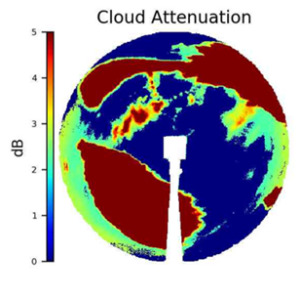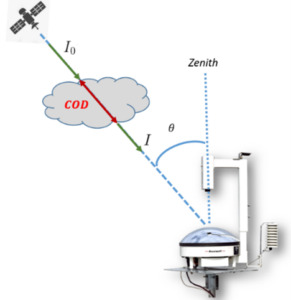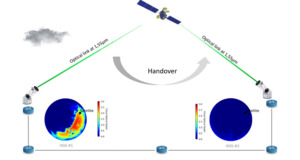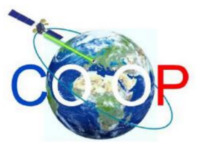Free-space optical communications play an important role in modern society: This technology facilitates the transmission of information without optical fibres, using lasers commonly in the infrared range, and taking advantage of an unobstructed line of sight between sender and receiver. It requires high precision in the alignment of the sender and receiver.
A decisive factor for successful data transmission using optical ground networks is the weather. Aerosols and clouds can significantly impact signal transmission. For this reason, precise weather forecasts are of great importance in order to be able to select the appropriate ground station, and react to possible changes in the cloud cover in good time by taking the right decision ensure the effectiveness of the selected connection.
Site selection of ground-based stations for space applications
Reuniwatt stands at the forefront of expertise in site survey and assessment for ground-based station sites for space applications. With a foundation built upon 15 years of experience and state-of-the-art technology, Reuniwatt specializes in analyzing historical atmospheric parameters such as weather phenomena, cloud cover, aerosol concentrations, and turbulence. This rigorous analysis allows Reuniwatt to offer comprehensive insights into the suitability of potential sites for deploying ground stations critical to space surveillance and communication endeavors.
Sky InSight™ sky imagers can provide you with a range of cloud characteristics. Reuniwatt is onboard the ANAtOLIA project. For more information, please contact us.(credits: Reuniwatt)
Site assessment
Site assessment plays a crucial role in the deployment of ground stations for various purposes such as optical, quantum, or space surveillance. Reuniwatt, with its specialized expertise in analyzing historical atmospheric parameters like weather, clouds, aerosols, and turbulence, offers a comprehensive approach to evaluating the potential of specific sites for establishing these critical stations. By delving into the intricate details of atmospheric conditions over time, Reuniwatt ensures a thorough understanding of the environment in which these ground stations will operate.
The overarching goal of site assessment is to ascertain the overall suitability of one or multiple locations for deploying a network of ground stations. This proactive approach enables stakeholders to make informed decisions before committing resources to actual deployment, thereby mitigating risks and maximizing efficiency. Identifying the ideal locations is paramount in constructing a robust ground network, and Reuniwatt’s methodology incorporates a spatio-temporal decorrelation process to ensure the highest availability rate under operational conditions.
Site survey
Site surveys conducted by Reuniwatt involve a meticulous examination of pre-selected sites, going beyond the first-level analysis. Through on-site measurements, precise environmental assessments, and the collection of specific data pertinent to station installation, Reuniwatt gathers comprehensive information essential for informed decision-making. Cutting-edge instruments are deployed to facilitate on-site measurements and observations, enabling a thorough measurement campaign that validates the suitability of locations for ground station installation. This rigorous approach ensures that every aspect of the site, from environmental factors to logistical considerations, is carefully evaluated to meet the stringent requirements of ground station deployment.
More resources:
Birch, M., Beattie, J. R., Bennet, F., Rattenbury, N., Copeland, M., Travouillon, T., … & Sayat, M. (2023). Availability, outage, and capacity of spatially correlated, Australasian free-space optical networks. Journal of Optical Communications and Networking, 15(7), 415-430.
Poulenard, S., Ruellan, M., Roy, B., Riédi, J., Parol, F., & Rissons, A. (2014, March). High altitude clouds impacts on the design of optical feeder link and optical ground station network for future broadband satellite services. In Free-Space Laser Communication and Atmospheric Propagation XXVI (Vol. 8971, pp. 58-67). SPIE.
Atmospheric characterization and forecasting for space applications
Reuniwatt stands as a frontrunner in cloud cover observation and atmospheric characterization. Leveraging cutting-edge technology and data analytics, Reuniwatt offers comprehensive solutions for monitoring cloud movements and assessing atmospheric conditions. By integrating advanced algorithms with state-of-the-art sensor networks, Reuniwatt enables precise forecasting of cloud cover dynamics.
Free-space optical communication entails transmitting data through laser beams in the absence of physical medium. This technology holds immense potential for inter-satellite communication and satellite-to-ground communication, offering higher data transfer rates and lower latency compared to traditional radio frequency communication. By harnessing laser beams, optical ground stations (OGS) can establish high-speed links with satellites orbiting in space, facilitating efficient data exchange for applications such as Earth observation, scientific research, and satellite telemetry.
Clouds can obstract optical link availability (credits: Reuniwatt)
Forecasting clear skies is paramount for enabling communication between satellites and optical ground stations (OGS). Optical communication relies heavily on direct line-of-sight between the transmitting and receiving ends, necessitating clear atmospheric conditions for optimal signal transmission. Predicting clear sky conditions allows OGS operators to schedule communication windows with orbiting satellites, ensuring uninterrupted data exchange even during nighttime when traditional radio frequency communication may be hindered by atmospheric interference or limited bandwidth.
Moreover, these forecasts play a crucial role in the systematic planning of optical link deployment for continuous communication. Once a network is established, accurate sky condition forecasts enable operators to dynamically adjust the alignment of optical links, optimizing data transmission efficiency and ensuring uninterrupted communication even in low-light conditions. By leveraging real-time weather data and advanced predictive analytics, operators can proactively mitigate potential disruptions and maintain seamless connectivity, thereby maximizing the utility of optical communication networks.
Cloud cover forecasts are essential to ensure the efficient selection of optical ground stations from a network of sites (credits: Reuniwatt)
Work with us
Reuniwatt is onboard several R&D projects to bring FSOC technology forward and from theory to everyday practics. We’re looking forward to meeting you and discuss a collaboration!
We have also partnered up with other FSOC experts to share our knowledge in our free webinar series:
No Clouds on the Horizon: The Future Looks Bright for FSOC
Initial broadcast date: January 25th, 2024
With Mynaric, Fraunhofer IOSB and Reuniwatt
Wireless Laser Communication: Don’t let clouds get in the way of success!
Initial broadcast date: June 24th, 2021
With Airbus, Systematic and Reuniwatt






